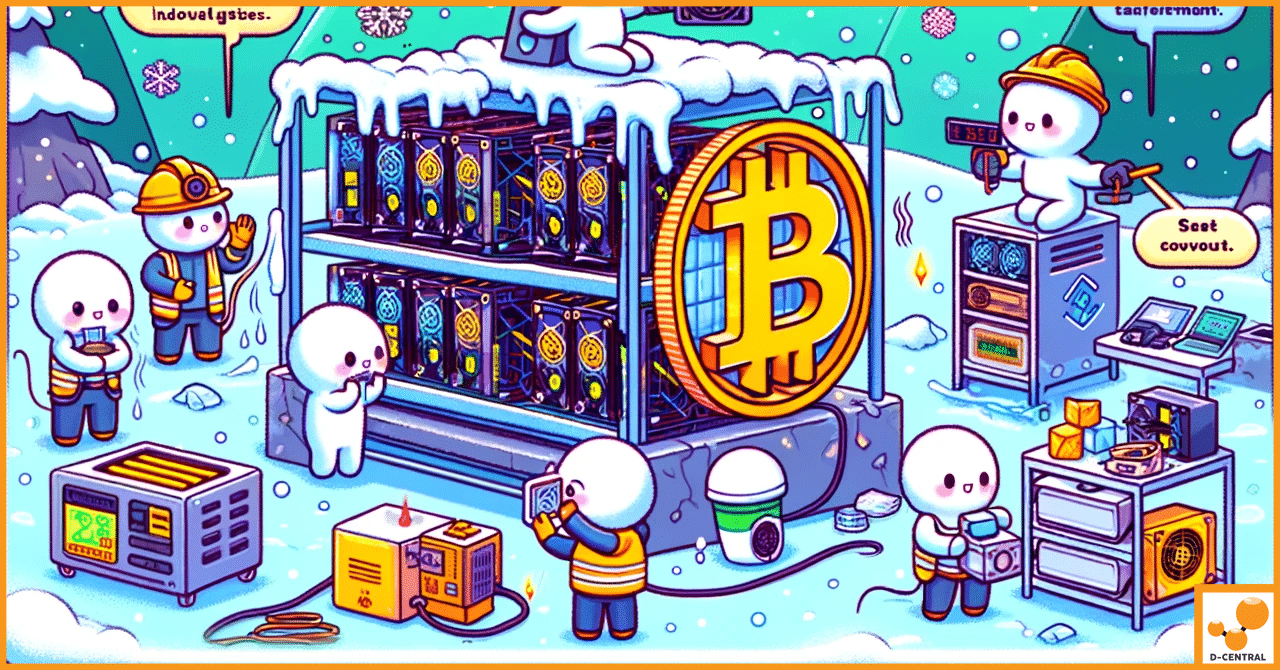
Quieting the Beast Soundproofing Techniques for a Peaceful Bitcoin Mining Operation
In the world of digital currencies, Bitcoin mining has made a significant mark. This computational process, instrumental in verifying transactions
4479 Desserte Nord Autoroute 440, Laval, QC H7P 6E2

In the rapidly evolving world of cryptocurrency, ASIC (Application-Specific Integrated Circuit) mining stands out as a cornerstone for securing blockchain networks and validating transaction blocks. These specialized devices are engineered to perform the singular task of mining cryptocurrencies, such as Bitcoin, with unparalleled efficiency and speed. The advent of ASIC miners marked a significant leap forward from earlier mining setups, offering a quantum leap in terms of computational power and energy efficiency. This technological advancement has not only intensified the mining competition but also democratized the ability to contribute to the blockchain, ensuring the network’s robustness and integrity.
However, the operation of ASIC miners is not without its challenges, especially when it comes to environmental conditions. Mining in cold climates presents a unique set of obstacles that can affect both the hardware’s efficiency and its overall longevity. The extreme low temperatures typical of such environments can lead to issues ranging from difficulty in starting up the machines to potential condensation problems, which may cause short circuits or other forms of damage to the sensitive electronic components. Moreover, the brittle nature of materials at sub-zero temperatures can increase the risk of physical damage to the hardware, further complicating the mining operations.
Addressing these challenges requires a nuanced understanding of the interplay between ASIC hardware and the cold conditions in which they operate. Strategies to mitigate the risks associated with cold climate mining are essential for maintaining the efficiency and prolonging the lifespan of these sophisticated machines. One such strategy involves the use of advanced mining firmware like Braiins OS+, which offers features specifically designed to optimize the performance of ASIC miners under a variety of conditions, including the cold. With adaptive solutions such as preheating protocols and enhanced power efficiency calculations, Braiins OS+ stands as a testament to the innovative approaches being developed to tackle the unique demands of mining in cold climates.
Understanding and implementing strategies to protect ASIC miners in cold climates is crucial for enhancing their longevity and performance. By leveraging advanced solutions like Braiins OS+ and adopting best practices tailored to cold environment operations, miners can overcome the challenges posed by extreme temperatures, ensuring the sustainable and efficient operation of their mining endeavors.
The operation of ASIC miners, the backbone of cryptocurrency mining, is significantly influenced by environmental conditions, particularly temperature. While much attention is given to the challenges of overheating in mining operations, the impact of extremely low temperatures on ASIC miner performance is equally critical yet often overlooked. Cold climates pose unique challenges that can affect both the efficiency and the longevity of mining hardware.
At the core of an ASIC miner’s functionality is its ability to perform complex computational tasks at high speeds. This process generates a substantial amount of heat, which, under normal conditions, requires effective cooling solutions to manage. However, in extremely cold climates, the ambient temperature can fall well below the optimal operating range for these devices. Such low temperatures can lead to a decrease in the electrical conductivity of the silicon used in the chips, adversely affecting the miner’s performance. The reduced thermal energy available in the environment can make it difficult for ASIC miners to reach the temperatures at which they operate most efficiently, leading to reduced hash rates and, consequently, lower mining outputs.
Maintaining an optimal operating temperature is crucial for the efficiency and safety of ASIC miners. While these devices are designed to handle high temperatures generated during operation, ensuring that they do not operate in conditions too far below their designed thermal range is equally important. Operating outside of this optimal range can lead to inefficiencies, increased wear and tear, and a higher likelihood of failure. Therefore, implementing strategies to manage the temperature of ASIC miners in cold climates is essential. This includes measures to gradually warm the devices before startup, protect them from direct exposure to cold air, and monitor for condensation risks. By maintaining the miners within their optimal temperature range, operators can ensure the safety, efficiency, and longevity of their investment, maximizing the profitability of their mining operations in even the most challenging climates.
Setting up a cryptocurrency mining operation in cold climates requires meticulous planning and consideration. The unique environmental challenges posed by such regions necessitate a strategic approach to site selection, infrastructure design, and equipment choice. By addressing these factors proactively, miners can mitigate the risks associated with extreme cold, ensuring the safety, efficiency, and longevity of their ASIC miners.
The first step in establishing a mining operation in a cold climate is choosing an appropriate location. The goal is to select a site that minimizes direct exposure to the harshest winter conditions while still taking advantage of the natural cooling benefits these environments offer. Factors to consider include:
Once a suitable site is selected, the focus shifts to designing and constructing mining facilities capable of withstanding cold climate challenges. Key infrastructure considerations include:
Not all ASIC miners are created equal, especially when it comes to operating in varied temperature ranges. When setting up a mining operation in a cold climate, it’s important to select equipment that is known to perform well under such conditions:
By carefully considering these pre-installation factors, miners can create a robust foundation for their cold climate mining operations. This proactive approach not only safeguards the hardware but also optimizes mining efficiency and productivity, turning the challenges of a cold environment into a competitive advantage.
Establishing a cryptocurrency mining operation in cold climates requires not just an understanding of the unique challenges presented by such environments but also the implementation of specific strategies to ensure optimal performance. This section provides a detailed guide on setting up your ASIC miner to tackle the cold climate challenges effectively, focusing on insulation techniques and power supply considerations.
Proper insulation is key to protecting your ASIC miners from the cold, but it’s equally important to maintain adequate airflow to prevent overheating. Here’s how to achieve this balance:
The power supply system is the lifeline of your mining operation. Cold temperatures can affect its reliability and efficiency, so consider the following:
By carefully considering these aspects when setting up your ASIC miners, you can create an efficient and resilient mining operation capable of thriving in cold climates. The key is to protect your hardware from the extreme cold while ensuring it has the stable power and optimal conditions needed to operate efficiently and safely.
Maintaining ASIC miners in peak condition is crucial for maximizing efficiency and profitability, especially in cold climates where environmental challenges can significantly impact performance. Implementing a robust maintenance strategy ensures that your mining operation remains productive and your hardware lasts longer. Here are key maintenance strategies tailored for cold climate operations:
Implementing these maintenance strategies can significantly enhance the performance and longevity of ASIC miners operating in cold climates. Regular maintenance not only prevents downtime and extends the life of your mining equipment but also ensures that your operation remains efficient and profitable despite the challenges posed by the environment. By prioritizing frequent checks, moisture control, and component care, miners can navigate the complexities of cold climate mining with confidence.
Mining in cold climates presents unique challenges, but with innovative solutions, these challenges can be transformed into advantages. From adaptive preheating systems to leveraging the natural cooling benefits of cold environments, miners have developed strategies to ensure their operations remain efficient and productive year-round. This section explores these solutions and highlights case studies of successful cold climate mining operations.
By embracing innovative solutions and learning from the successes of others, miners in cold climates can overcome the challenges posed by their environment and turn potential disadvantages into operational strengths. Adaptive preheating systems and the strategic use of natural cooling are just the beginning, as ongoing technological advancements promise even more effective strategies for cold climate mining in the future.
Mining in cold climates can introduce specific challenges that impact the performance and reliability of ASIC miners. Understanding how to troubleshoot and prevent common issues such as startup failures, efficiency drops, and hardware malfunctions is crucial for maintaining a productive mining operation. This section provides insights into addressing these challenges effectively.
By proactively addressing these common cold climate mining issues, operators can significantly reduce downtime and maintain the efficiency and longevity of their ASIC miners. Regular maintenance, environmental monitoring, and the use of advanced firmware solutions are key to navigating the challenges of mining in cold climates successfully.
The unique challenges of operating ASIC miners in cold climates underscore the critical importance of adopting specialized strategies to protect this valuable hardware. From the risk of startup failures due to freezing temperatures to the potential for condensation and material brittleness, cold climates present a range of obstacles that can impact operational efficiency and the longevity of mining equipment. However, with the right approach, these challenges can be effectively managed, turning the natural cooling advantages of cold environments into a boon for mining operations.
Implementing adaptive preheating systems, optimizing infrastructure for insulation and ventilation, and selecting equipment suited for low-temperature operation are just a few of the strategies that can help ensure your mining operation thrives in cold climates. Regular maintenance, moisture control, and staying vigilant for signs of hardware malfunctions are also crucial for maintaining peak performance and preventing costly downtime.
As the cryptocurrency mining industry continues to evolve, staying informed about new technologies and solutions is essential for maximizing the efficiency and profitability of your operation. Innovations in mining firmware, like Braiins OS+, offer features specifically designed to address the challenges of cold climate mining, highlighting the industry’s ongoing efforts to adapt to diverse environmental conditions.
We encourage readers to share their own experiences and tips for mining in cold climates. Your insights can provide valuable guidance for fellow miners navigating similar challenges and contribute to the collective knowledge of the mining community. Additionally, subscribing to newsletters or participating in forums dedicated to mining technology and strategies can be an excellent way to stay updated on the latest developments and best practices in the field.
By implementing the outlined strategies and actively engaging with the mining community, you can enhance the resilience and efficiency of your cold climate mining operation. Together, we can continue to push the boundaries of what’s possible in cryptocurrency mining, regardless of the environmental challenges we face.
What challenges do ASIC miners face in cold climates?
ASIC miners in cold climates encounter challenges such as startup difficulties, condensation risks, material brittleness, decreased electrical conductivity in silicon chips, and reduced performance due to low ambient temperatures.
How does cold climate affect ASIC miner performance?
Cold climates can lead to a decrease in the electrical conductivity of silicon, making it difficult for ASIC miners to reach optimal operating temperatures. This results in reduced hash rates and mining outputs.
What strategies can mitigate risks associated with cold climate mining?
Strategies include using advanced mining firmware like Braiins OS+, which optimizes performance under various conditions, including cold climates. Measures to gradually warm devices before startup and protect them from direct cold air exposure are also effective.
What are key considerations for setting up a mining operation in cold climates?
Key considerations include site selection to minimize exposure to extreme cold, designing mining facilities with proper insulation and ventilation, controlling moisture inside the facility, and choosing ASIC miners known for reliable performance in cold conditions.
How can miners optimize ASIC miner setup for cold conditions?
Miners can balance insulation and airflow using enclosures, incorporate strategic venting, manage the airflow path, ensure the power supply system components are rated for low temperatures, and optimize power setups to take advantage of natural cooling.
What maintenance strategies ensure peak performance in cold climates?
Regular maintenance schedules, frequent checks and cleaning to maintain airflow, software updates, dehumidification, careful inspection of sensitive components, and adjustments based on environmental monitoring are essential for peak performance.
What are innovative solutions for cold climate mining?
Innovative solutions include adaptive preheating systems to bring miners to optimal operating temperatures and leveraging natural cooling benefits. Strategic facility design and the integration of renewable energy sources can also contribute to efficient mining operations in cold climates.
How can common cold climate mining issues be troubleshooted?
Troubleshooting involves implementing adaptive preheating systems to prevent startup failures, monitoring for efficiency drops, and identifying hardware malfunctions. Strategies include ensuring stable power supply, controlling moisture to prevent condensation, and inspecting for physical damage due to cold.
DISCLAIMER: D-Central Technologies and its associated content, including this blog, do not serve as financial advisors or official investment advisors. The insights and opinions shared here or by any guests featured in our content are provided purely for informational and educational purposes. Such communications should not be interpreted as financial, investment, legal, tax, or any form of specific advice. We are committed to advancing the knowledge and understanding of Bitcoin and its potential impact on society. However, we urge our community to proceed with caution and informed judgment in all related endeavors.
Related Posts

In the world of digital currencies, Bitcoin mining has made a significant mark. This computational process, instrumental in verifying transactions

In the dynamic world of cryptocurrency mining, Application-Specific Integrated Circuit (ASIC) miners have emerged as the gold standard. Unlike their

In the dynamic world of cryptocurrency mining, Application-Specific Integrated Circuit (ASIC) miners have emerged as specialized and powerful tools. These